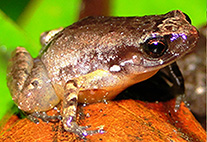Abstract
We describe a new species of Noblella from wet, montane forest at the Sardinayacu Lake Complex between 1600–1920 m elevation in Morona Santiago, Ecuador. The new species differs from congeners in having three phalanges in the fourth finger, finely tuberculate skin on the dorsal body, pointed digital tips with marginal grooves on the fingers, a yellow to pale yellow venter, and a reduced facial mask not extending beyond the arm. The new species also lacks the pair of inguinal spots on the dorsal flanks of most congeners. Since its discovery in 1976, N. lochites has remained poorly known. We describe variation, color in life, and basic ecology of N. lochites based on a large series from the Cordillera del Condor.
References
Almendáriz, A. (1997) Overview of the herpetofauna of the western slopes of the Cordillera del Cóndor. In: Schulenberg, T.S. & Awbrey, K. (Eds), The Cordillera del Cóndor region of Ecuador and Peru: A Biological Assessment. Conservation International, Washington, D.C., pp. 80–82.
Almendáriz, A., Ron, S.R. & Britto M., J. (2012) Una especie nueva de rana venenosa de altura del género Excidobates (Dendrobatoidea: Dendrobatidae) de la Cordillera del Cóndor. Papéis Avulsos de Zoologia, 52, 387–389.
http://dx.doi.org/10.1590/S0031-10492012021200001Barbour, T. (1930) A list of Antillean reptiles and amphibians. Zoologica, 11, 61–116.
Bernal, M.H., Montealegre, D.P. & Páez, C.A. (2004) Estudio de la vocalización de trece especies de anuros del municipio de Ibagué, Colombia. Revista de la Academia Colombiana de Ciencias Exactas, Físicas y Naturales, 28, 385–390.
Cerón, C.E. (2001) Dos nuevas formaciones naturales del Ecuador. Revista Cinchionia, 2, 1–4.
Chen, M.H. & Combs, C.A. (1999) An alternative anesthesia for amphibians: ventral application of benzocaine. Herpetological Review, 30, 34.
Cisneros-Heredia, D.F. & Reynolds, R.P. (2007) New records of Phyllonastes Heyer, 1977 from Ecuador and Peru. Herpetozoa, 19, 184–186.
Cocroft, R.B. & Ryan, M.J. (1995) Patterns of advertisement call evolution in toads and chorus frogs. Animal Behaviour, 49, 283–303.
http://dx.doi.org/10.1006/anbe.1995.0043De la Riva, I. & Köhler, J. (1998) A new minute leptodactylid frog, genus Phyllonastes, from humid montane forests of Bolivia. Journal of Herpetology, 32, 325–329.
http://dx.doi.org/10.2307/1565445De la Riva, I., Chaparro, J.C. & Padial, J.M. (2008) The taxonomic status of Phyllonastes Heyer and Phrynopus peruvianus (Noble) (Lissamphibia, Anura): resurrection of Noblella Barbour. Zootaxa, 1685, 67–68.
Duellman, W.E. (1991) A new species of leptodactylid frog, genus Phyllonastes, from Peru. Herpetologica, 47, 9–13.
Duellman, W.E. & Lehr, E. (2009) Terrestrial-Breeding Frogs (Strabomantidae) in Peru. Natur und Tier Verlag, Münster, Germany, 382 pp.
Duellman, W.E. & Lynch, J.D. (1988) Anuran amphibians from the Cordillera de Cutucú, Ecuador. Proceedings of the Academy of Natural Sciences of Philadelphia, 140, 125–142.
Fouquet, A., Loebmann, D., Castroviejo-Fisher, S., Padial, J.M., Orrico, V.G.D., Lyra, M.L., Roberto, I.J., Kok, P.J.R., Haddad, C.F.B. & Rodrigues, M.T. (2012) From Amazonia to the Atlantic forest: Molecular phylogeny of Phyzelaphryninae frogs reveals unexpected diversity and a striking biogeographic pattern emphasizing conservation challenges. Molecular Phylogenetics and Evolution, 65, 547–561.
http://dx.doi.org/10.1016/j.ympev.2012.07.012Guayasamin, J. M. & Terán-Valdez, A. (2009) A new species of Noblella (Amphibia: Strabomantidae) from the western slopes of the Andes of Ecuador. Zootaxa, 2161, 47–59.
Hammer, Ø., Harper, D. A. T. & Ryan, P. D. (2001) PAST: Paleontological Statistics Software Package for Education and Data Analysis. Palaeontologia Electronica, 4, 1–9.
Hedges, S.B., Duellman, W.E. & Heinicke, P. (2008) New world direct-developing frogs (Anura: Terrarana): molecular phylogeny, classification, biogeography, and conservation. Zootaxa, 1737, 1–182.
Heinicke, M.P., Duellman, W.E. & Hedges, S.B. (2007) Major Caribbean and Central American frog faunas originated by ancient oceanic dispersal. Proceedings of the National Academy of Sciences,104, 10092–10097.
http://dx.doi.org/10.1073/pnas.0611051104Heyer, W.R. (1977) Taxonomic notes on frogs from the Madeira and Purus rivers, Brazil. Papéis Avulsos de Zoologia, São Paulo, 8, 141–162.
Köhler, J. (2000) A new species of Phyllonastes Heyer from the Chapare region of Bolivia, with notes on Phyllonastes carrascoicola. Spixiana, 23, 47–53.
Lehr, E. & Catenazzi, A. (2009) A new species of minute Noblella (Anura: Strabomantidae). Copeia, 2009, 148–156.
http://dx.doi.org/10.1643/CH-07-270Lehr, E., Aguilar, C. & Lundberg, M. (2004) A new species of Phyllonastes from Peru (Amphibia, Anura, Leptodactylidae). Journal of Herpetology, 38, 214–218.
http://dx.doi.org/10.1670/135-03ALynch, J.D. (1976) Two new species of frogs of the genus Euparkerella (Amphibia: Leptodactylidae) from Ecuador and Perú. Herpetologica, 32, 48–53.
Lynch, J.D. (1986) New species of minute leptodactylid frogs from the Andes of Ecuador and Peru. Journal of Herpetology, 20, 423–431.
http://dx.doi.org/10.2307/1564505Noble, G.K. (1921) Five new species of Salientia from South America. American Museum Novitates, 29, 1–7.
Pyron, R.A. & Wiens, J.J. (2011) A large-scale phylogeny of Amphibia including over 2800 species, and a revised classification of extant frogs, salamanders, and caecilians. Molecular Phylogenetics and Evolution, 61, 543–583.
http://dx.doi.org/10.1016/j.ympev.2011.06.012Reynolds, R.P. & Icochea, M.J. (1997) Amphibians and reptiles of the upper Rio Comainas, Cordillera del Cóndor. In: Schulenberg, T.S. & Awbrey, K. (Eds), The Cordillera del Cóndor region of Ecuador and Peru: A Biological Assessment. Conservation International, Washington, D.C., pp. 82–86.
Simmons, J. E. (2002) Herpetological collecting and collection management. Herpetological Circular, 31, 1–153.

